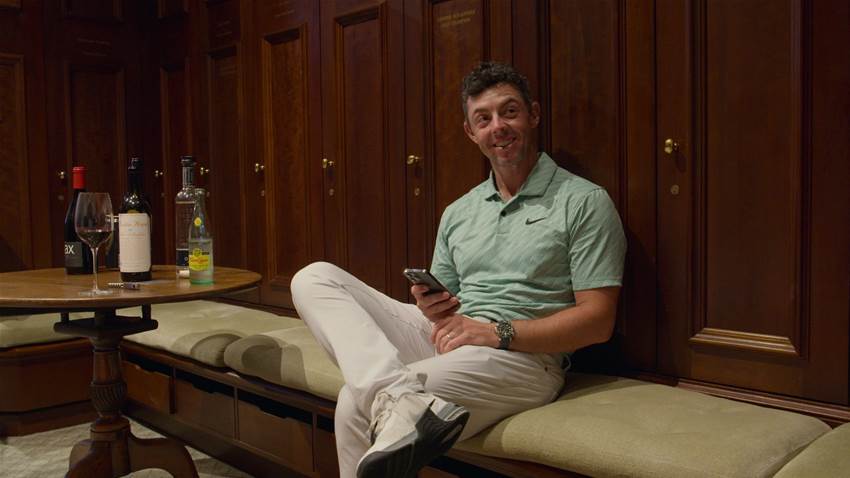Golf has a problem with an excess of choice. Any given week there’s three or four tournaments on the men’s premier Tours and at least that again on secondary and feeder circuits.
Almost anyone can win on any given week and the marquee players at any given event are no sure thing to even contend. The handful of golf’s truly elite players are peppered across multiple continents like infinity stones cast to the edges of the galaxy, their true star power is only rarely realised when united at the four majors and occasional team events.
All the other weeks there’s a lot of Tours, a lot of tournaments, a lot of players and a lot of storylines. In summary: it’s a lot!
And if you’re the producers of a Netflix series with a lot of cameras and a lot of access to a lot of players, that’s well … a lot to condense down into eight tight episodes of documentary TV.
In the trailer for Full Swing Ian Poulter teases “you picked a hell of a year to start following the PGA Tour.”
Indeed they did, but the sheer volume of content last year may have cursed the show’s producers with a paradoxical problem of choice overload.
 The first and probably most difficult choice was to decide which players to put in the spotlight. Back when the series was first announced there were a couple of dozen players who agreed to participate. In the final product almost half of those have ended on the cutting room floor.
The first and probably most difficult choice was to decide which players to put in the spotlight. Back when the series was first announced there were a couple of dozen players who agreed to participate. In the final product almost half of those have ended on the cutting room floor.
The series viewed as a whole, does a decent job of justifying its choices with a rationale that was perhaps biased towards variety. They chose the players who were most unlike each other – at different phases of their career and at different rungs in the professional golf ladder.
It suggests they wanted to tell the story of professional golf through the prism of various player’s lives. What results is something like a golf themed Rashomon homage. The same historical events revisited episode after episode, but each time recounted by a different player.
So rather than try and show events unfolding in parallel, each episode resets the clock to the start of the year and effectively pretends like the individual player’s story is unfolding in isolation.
Therein lies another choice – should they have simply introduced the characters upfront and shown everyone’s progression through the year in one season long timeline? It may have allowed for more interaction between the main players, but it could also have been pretty darn confusing.
"We get to see alpha dog Brooks Koepka spending a whole episode as a surprisingly vulnerable human." - Adrian Logue.
In the end that choice might have been made for them as it will shock nobody to learn that the top professional golfers mostly exist in their own individual gilded bubbles of banality. The fleeting moments of players intermingling are usually in the most inconsequential circumstances – a bro-y high five outside the scorers hut or a lame quip in the player’s lounge.
That’s not to say there aren’t good stories to be told in this manner. We get to see alpha dog Brooks Koepka spending a whole episode as a surprisingly vulnerable human – moping around and searching under various luxurious sofas for his lost mojo.
In another episode veteran Poulter comes to terms with a fading talent while still spinning his charismatic brand with a panache that might just see him through professional golf’s wilderness from age 45-50.
Some episodes split their attention between multiple players. In all there’s around ten players who get a decent slice of screen time across the whole season, and maybe half a dozen more with secondary roles.

Among those we spend a lot of time with are some curious choices. There’s a whole episode with Joel Dahmen – a fine player who can beat the best when at his own best. Golf fans will enjoy getting to know him, but perhaps his is a story best left to one of the many niche golf media outlets that can deliver it via a YouTube special.
Even Joel (maybe especially Joel) would be surprised that a production of Netflix’s scale would pause on him for an entire episode of an eight-part series. Even if a hoard of Dahmen-ites somehow emerges from Netflix’s non-golf audience, they might end up disillusioned by what they see on the leaderboard each week in their freshly downloaded PGA Tour app.
If there’s a narrative through-line to the overall season it’s in the build-up and teasing of Rory McIlroy’s introduction. When it eventually comes, Rory’s presence electrifies the series and delivers a genuinely thrilling 47mins of streaming entertainment.
One wonders if the show runners considered the option of putting Rory’s episode up front? The early episodes are burdened with a fair bit of heavy lifting to ease in a non-golf audience.
We’re introduced to a supporting cast of various golf media sitting three-quarter-view and talking interview-style in beautifully lit interiors. The perfect setting to patiently frame the context for each scene. There’s some talented and knowledgeable golf minds among those talking heads, but they aren’t given a lot of opportunity to colour up the exposition.
Full Swing tasks itself with acquainting non-golfers with a jargon heavy sport, a confusing schedule of tournaments, an inscrutable scoring format and a dozen or so personalities seemingly selected at random from literally hundreds of players.
The subjects are introduced throughout the series with captions under their names like “World No.118” or “World No.23”. Surely someone new to golf would be wondering how many significant players they’re not seeing!? If this was a fly-on-the-wall series about Accountants, would it be like following the world’s 2,043rd ranked CPA?
Despite that careful handholding there is still much left to assumed knowledge and one wonders if non-golfers will understand what’s at stake in any given scenario. Many probably won’t make it past the surprisingly long scene in episode three of Ian Poulter pottering around his ostentatious closet as he meticulously packs four days’ worth of clothes for what turns out to be just two days of golf at the 2022 PGA Championship.
It is this quest to tap into a non-golf audience that leads us to the inevitable comparisons to the Netflix Formula 1 series Drive to Survive, and this is where the weight of golf’s profusion of choice is really felt.

F1 has just twenty drivers competing in a couple of dozen races. Even with so few (comparative) choices to make, the F1 show runners narrow their focus down to a handful of key personalities.
Add to that, every F1 competitor must show up to every event and most of the action is contained in a relatively small trackside paddock. The edit of each season of Drive to Survive can more or less follow the season in chronological order and show clashing points of view and dramatic interactions between the principal characters as they unfold. All this while still having the luxury to focus attention on one team each race week and tell a variety of stories from all parts of the paddock. It works very well.
Perhaps if the top echelon of elite men’s golf consisted of a compact season of say … twenty weeks (including the majors) with every top player forced to compete in every one of those weeks, and if the season-long race actually had the prestige of a world championship then Netflix could conceivably put together a golf series with the drama and collisions of personality that we enjoy so much in Drive to Survive.
Instead, golf has the PGA Tour – a slow-moving, reactive incumbent hogging almost every week of the year and a clumsy, problematic disruptor in the form of LIV Golf that has failed to lure away the majority of top players. It’s the worst of both worlds and rather than elevate the week-to-week competition it has only served to heighten the importance of the majors as the only stage on which all the top players (for the moment) can actually compete for the few career-defining moments that anyone truly cares about.
Rather than setting the scene for a team PGA Tour versus team LIV Golf fan frenzy, the current state of professional golf almost forces Full Swing to focus more on the majors. The few times the series explores regular Tour events (whether they be PGA Tour or LIV), the visuals and sense of occasion are noticeably flat.
"Full Swing is the most anticipated piece of golf media of 2023 and from its announcement over a year ago it has perhaps had unrealistic expectations piled on it." - Adrian Logue.
Also missing from Full Swing are a proxy for the unexpected stars of Drive to Survive – the team bosses. Pre-Drive to Survive, F1 newbies would probably have at least heard of a famous driver like Lewis Hamilton. Post-Drive to Survive they care deeply whether Mercedes boss Toto Wolff can get his breakfast pumpernickels toasted just how he likes them.
Disappointingly, Full Swing won’t be a vehicle for a similarly charismatic non-player to have their pumpernickel moment. Rory is the one and only bona fide star of the series. And taking nothing away from Rory, that may not be enough to captivate a sustained following.
Every hero needs a foil. Toto Wolff has Christian Horner, Lewis Hamilton has Max Verstappen, Gunter Steiner has himself. From among the players featured in Full Swing, the obvious foil to Rory would be Dustin Johnson.
The series is successful in highlighting just how much presence Rory and DJ command at a golf tournament. You could know nothing about golf but with one glimpse of DJ’s swagger you’re thinking “who is that?”. As impressive as DJ is, Rory’s presence emanates from some preternatural internal energy that turns heads and parts crowds.
Fortunately Netflix had cameras on both Rory and DJ, and with Rory as flag bearer for the PGA Tour and DJ as one of LIV’s biggest stars, you’d think they must have found a way to create a fan driven narrative around team PGA vs team LIV?
Sadly not.
It’s win or go home.
— Netflix (@netflix) February 6, 2023
Full Swing — your new sports doc obsession from the creators of Drive to Survive — premieres February 15. pic.twitter.com/QEq7DlxXrx
Rory and DJ are featured in separate episodes and Rory for his part seems more obsessed with Phil Mickelson who isn’t a participant in the series, while DJ’s incredibly positive self-image shuts down any controversy saying “I don’t care what people think” with such powerful conviction that you can almost see the off-camera interviewer slowly fold into the foetal position.
Full Swing is the most anticipated piece of golf media of 2023 and from its announcement over a year ago it has perhaps had unrealistic expectations piled on it. Men’s professional golf as a mainstream product is a remarkably fractured and diluted sport mostly populated by fiercely independent players who rarely cross paths in a competitive setting.
Faced with an excess of players, Tours, tournaments and administrators all of them eager to help Netflix achieve for golf what it did for F1, you can’t help but feel some sympathy for the difficult choices that must have been required to create a focused and compelling docuseries. Did they choose the right players? Did they fit those players’ experiences to the right storylines? Did they choose the right episode structure to tell those stories?
No doubt there’ll be some obscure metric to pass judgement – subscriber churn rate or similar. The golf industry will grade the series firstly on its impact on a non-golf audience and failing that, they’ll hope that it’s at least something golfers can enjoy.
It’s success or failure cannot entirely be attributed to the show’s producers, it will largely reflect on the state of golf and whether a broadly appealing product can be distilled from the overabundance of choices that golf itself has been unable to resolve.
Full Swing premiers on Netflix globally February 15.
Related Articles

Playing From The Tips Ep.116: US Open and Meijer LPGA Classic

Playing From The Tips Ep.115: Canadian Open, LIV Virginia, ShopRite & KLM Open













